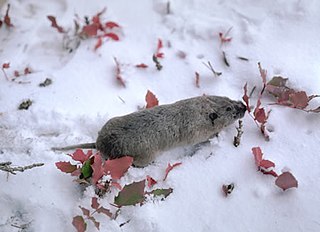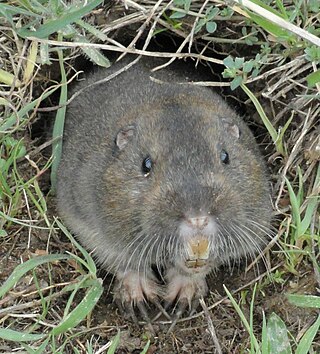
The northern pocket gopher is a small gopher species native to the western United States and the Canadian provinces of Alberta, Saskatchewan, British Columbia, and Manitoba.
The Tacoma pocket gopher was a subspecies of the Mazama pocket gopher that was restricted to a few isolated populations in the southern Puget Sound area and on the Olympic Peninsula in Washington. The animal became extinct in 1970.

Pocket gophers, commonly referred to simply as gophers, are burrowing rodents of the family Geomyidae. The roughly 41 species are all endemic to North and Central America. They are commonly known for their extensive tunneling activities and their ability to destroy farms and gardens.

The smooth-toothed pocket gophers, genus Thomomys, are so called because they are among the only pocket gophers without grooves on their incisors. They are also called the western pocket gophers because they are distributed in western North America. They are considered distinct enough from other pocket gophers to be recognized as a separate subfamily or tribe.

The Mazama pocket gopher is a smooth-toothed pocket gopher restricted to the Pacific Northwest. The herbivorous species ranges from coastal Washington, through Oregon, and into north-central California. Four subspecies of the Mazama Pocket Gopher are classified as threatened under the Endangered Species Act of 1973, including T. m. pugetensis, T. m. tumuli , T. m. glacialis, and T. m. yelmensis. The Mazama Pocket Gopher is one of the smallest of 35 species in the pocket gopher family.

Botta's pocket gopher is a pocket gopher native to western North America. It is also known in some areas as valley pocket gopher, particularly in California. Both the specific and common names of this species honor Paul-Émile Botta, a naturalist and archaeologist who collected mammals in California in 1827 and 1828.

The gray-tailed vole also known as the gray-tailed meadow vole or gray-tailed meadow mouse, is a rodent in the genus Microtus of the family Cricetidae. Voles are small mammals, and this species lies roughly in the middle of their size range. First collected in 1895, it is endemic to the Willamette Valley, Oregon, and Clark County, Washington, in the Pacific Northwest region of North America. Historically, they were found in the prairie areas of the Valley and, though many of these areas have been converted for agricultural purposes, these animals remain common. For reasons that remain unclear, vole population densities in any area may fluctuate widely from season to season and year to year. They are preyed upon by owls, hawks, and carnivorous mammals, and their parasites include fleas and ticks. These voles build burrows and complex tunnel networks, which they sometimes share with other burrowing animals. Relatively little is known about their behavior in the wild, because they are elusive and unlikely to enter traps.

The camas pocket gopher, also known as the camas rat or Willamette Valley gopher, is a rodent, the largest member in the genus Thomomys, of the family Geomyidae. First described in 1829, it is endemic to the Willamette Valley of northwestern Oregon in the United States. The herbivorous gopher forages for vegetable and plant matter, which it collects in large, fur-lined, external cheek pouches. Surplus food is hoarded in an extensive system of tunnels. The dull-brown-to-lead-gray coat changes color and texture over the year. The mammal's characteristically large, protuberant incisors are well adapted for use in tunnel construction, particularly in the hard clay soils of the Willamette Valley. The gophers make chattering sounds with their teeth; males and females make purring sounds when they are together, and the young make twittering sounds. Born toothless, blind and hairless, the young grow rapidly before being weaned at about six weeks of age.

The Wyoming pocket gopher is a species of gopher that is endemic to the United States. Between 1915 and 1979, it was generally considered to be a subspecies of the northern pocket gopher.

The Idaho pocket gopher is a species of rodent in the family Geomyidae. It is rather small, with a lightly built skull. Its fur color varies through the body and between individuals. Found in the western United States, it inhabits savannas, shrubland, and grasslands. Individuals live alone in burrows, staying active year-round. Many aspects of its behavior and biology are not well understood. The species is classified as being of least-concern by the International Union for the Conservation of Nature.

The mountain pocket gopher is a species of rodent in the family Geomyidae. It is endemic to California and Nevada. The Sierra Nevada are part of its range.

Townsend's pocket gopher is a species of pocket gopher endemic to the northwestern United States.

The southern pocket gopher is a species of rodent in the family Geomyidae. It is found in Mexico and the United States, usually in high altitude grassland and shrubland. It feeds on plant material and has an extensive burrow above which is a large heap of earth on the surface of the ground.
The Iron Canyon Site is a Miocene assemblage of vertebrate fossils located in Kern County, California within the Dove Spring Formation dating from ~23.03—5.33 Ma.

James Lloyd Patton, is an American evolutionary biologist and mammalogist. He is emeritus professor of integrative biology and curator of mammals at the Museum of Vertebrate Zoology, UC Berkeley and has made extensive contributions to the systematics and biogeography of several vertebrate taxa, especially small mammals.
Geomydoecus oregonus is a species of louse known to affect the Camas pocket gopher.
Hymenolepis tualatinensis a species of parasitic cestodes (tapeworms), in the genus Hymenolepis. It was originally described in 1985 from the gastrointestinal tract of the Camas pocket gopher.












